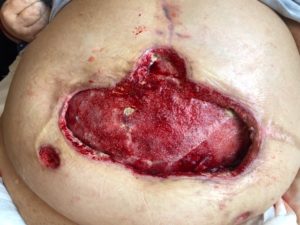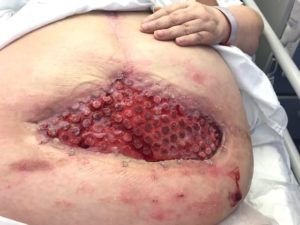Case Study
Patient History:
62 year old female, smoker, gout, chronic back pain and obesity. Patient was also wheelchair bound and suffered with anxiety and depression.
Wound and Treatment History:
Abdominal surgical dehiscence, post laparotomy and ventral hernia repair with external oblique component separation and onlay of mesh on 10/3/19.
Midline abdominal wound dehiscence first noted on 15/3/19 (Fig. 1), abdominal wound size 14cm L x 9cm W x 3cm D. Negative Pressure Wound Therapy (NPWT) on 15/3/19. Dressing changes three times per week.
Fig 1.

Fig 2. Fig 3.


Fig 4.

Surgical debridement and closure of abdominal dehiscence with split thickness skin graft (STSG) on 17/6/19. Donor site on right upper thigh.
Unfortunately, 7 days post-operative (post-op) the STSG did not take despite management with NPWT (Fig. 2). On 24/6/19, post-op NPWT with Instillation and Dwell (NPWTi-d) with Reticulated Open Cell Foam Dressing with Through Holes (ROCF-CC) and polyhexamethylene biguanide (PHMB) for 2 weeks to help heal abdominal wound. Dressing changes three times per week. First dressing change (Fig.3) and second dressing change (Fig. 4).
NPWTi-d removed from abdominal wound after 2 weeks and daily dressing regime was normal saline clean, dress abdomen with povidone iodine as primary dressing and highly absorbent dressing with retention tape as secondary dressing.
Donor site to right upper thigh healing well, applied sorbolene cream only.
Patient discharged to aged care facility. Local General Practitioner provided ongoing wound reviews. Bankstown Hospital Plastics Clinic Ambulatory Care on 10/7/2019.
Outcome:
NPWTi-d with ROCF-CC and PHMB assisted with removal of excessive exudate, increased perfusion to wound bed, increased of granulation tissue to achieve closure of abdominal wound dehiscence.